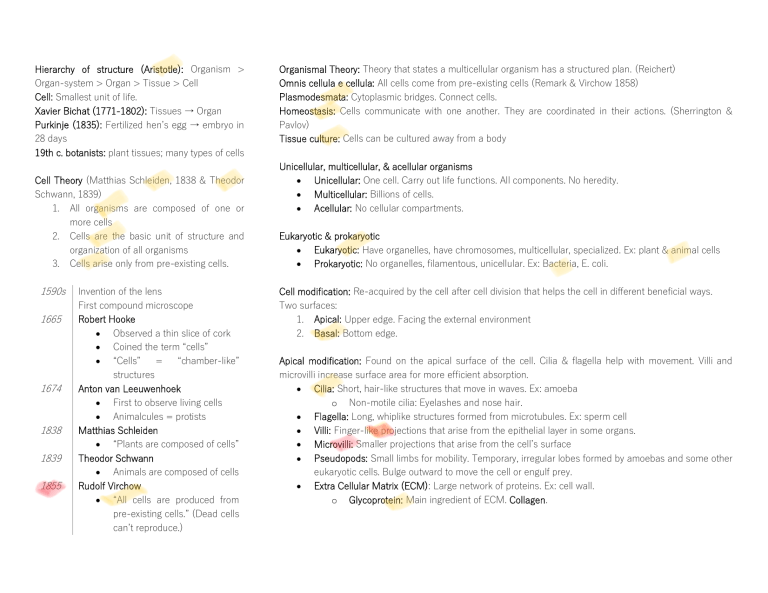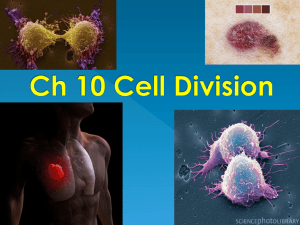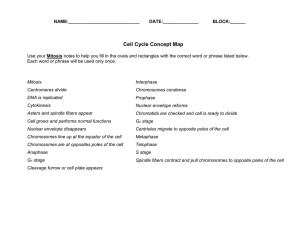
Hierarchy of structure (Aristotle): Organism > Organ-system > Organ > Tissue > Cell Cell: Smallest unit of life. Xavier Bichat (1771-1802): Tissues → Organ Purkinje (1835): Fertilized hen’s egg → embryo in 28 days 19th c. botanists: plant tissues; many types of cells Cell Theory (Matthias Schleiden, 1838 & Theodor Schwann, 1839) 1. All organisms are composed of one or more cells 2. Cells are the basic unit of structure and organization of all organisms 3. Cells arise only from pre-existing cells. 1590s 1665 1674 1838 1839 1855 Invention of the lens First compound microscope Robert Hooke • Observed a thin slice of cork • Coined the term “cells” • “Cells” = “chamber-like” structures Anton van Leeuwenhoek • First to observe living cells • Animalcules = protists Matthias Schleiden • “Plants are composed of cells” Theodor Schwann • Animals are composed of cells Rudolf Virchow • “All cells are produced from pre-existing cells.” (Dead cells can’t reproduce.) Organismal Theory: Theory that states a multicellular organism has a structured plan. (Reichert) Omnis cellula e cellula: All cells come from pre-existing cells (Remark & Virchow 1858) Plasmodesmata: Cytoplasmic bridges. Connect cells. Homeostasis: Cells communicate with one another. They are coordinated in their actions. (Sherrington & Pavlov) Tissue culture: Cells can be cultured away from a body Unicellular, multicellular, & acellular organisms • Unicellular: One cell. Carry out life functions. All components. No heredity. • Multicellular: Billions of cells. • Acellular: No cellular compartments. Eukaryotic & prokaryotic • Eukaryotic: Have organelles, have chromosomes, multicellular, specialized. Ex: plant & animal cells • Prokaryotic: No organelles, filamentous, unicellular. Ex: Bacteria, E. coli. Cell modification: Re-acquired by the cell after cell division that helps the cell in different beneficial ways. Two surfaces: 1. Apical: Upper edge. Facing the external environment 2. Basal: Bottom edge. Apical modification: Found on the apical surface of the cell. Cilia & flagella help with movement. Villi and microvilli increase surface area for more efficient absorption. • Cilia: Short, hair-like structures that move in waves. Ex: amoeba o Non-motile cilia: Eyelashes and nose hair. • Flagella: Long, whiplike structures formed from microtubules. Ex: sperm cell • Villi: Finger-like projections that arise from the epithelial layer in some organs. • Microvilli: Smaller projections that arise from the cell’s surface • Pseudopods: Small limbs for mobility. Temporary, irregular lobes formed by amoebas and some other eukaryotic cells. Bulge outward to move the cell or engulf prey. • Extra Cellular Matrix (ECM): Large network of proteins. Ex: cell wall. o Glycoprotein: Main ingredient of ECM. Collagen. Basal modification: Found on the basal surface of the cell. • Desmosomes/Hemidesmosomes: Anchoring junction of the basal surface of the cell. Rivet-like links between cytoskeleton and extracellular matrix components such as the basal lamina that underlie epithelia. Primarily composed of keratin, integrins and cadherins. Connect two cells Lateral modification: Found on the basal surface of the cell. Serves as a barrier. • Tight junction: Act as barriers that regulate the movement of water and solutes between epithelial layers. Prevent leakage of ECF. • Adhering junction: Anchoring junction. Fasten cells to one another. • Gap junction: Communicating junctions. Closable channels that connect the cytoplasm of adjoining animal cells. Allow direct exchange of chemical between the cytoplasm of two cells. Specialized Cells Roots: Absorb water and dissolve nutrients. Anchor plants to the ground. Helps the plant grow. Cells divide at the root tip or root cap. • Apical meristems: Where the plant grows from. Growth regions. Not completely specialized. • Meristem tissue: The only place where mitosis takes place in plants Stems: Three functions: (1) Produce leaves, branches and flowers. (2) Hold leaves up to the sunlight. (3) Transport substances between roots and leaves. • Xylem and phloem: Transport systems of the plant • Xylem: Transports water upward from the roots • Phloem: Transports carbohydrates and nutrients produced by photosynthesis Leaves: Absorb light and carry out the process of photosynthesis • Cuticle: A waxy covering that prevents water loss. • Epidermis: Layer under the cuticle • Mesophyll: Under the epidermis. Where photosynthesis takes place. • Xylem and phloem: Under the epidermis as well. • Stoma/stomata: Little openings on the underside of leaves. Where oxygen leaves. • Guard cells: Cells that close the stomata. Blood • Red blood cells: Carry oxygen to all parts of the body, CO2 back to the lungs. No nucleus, few mitochondria, not much ATP. Muscle • Skeletal muscles: For movement. Attached to bones. Voluntary. Lots of mitochondria, lots of ATP. • Smooth muscles: Stomach, blood vessels, intestines. Not voluntary. Lots of mitochondria, lots of ATP. • Cardiac muscles: Only in the heart. Never stops. Not voluntary. Lots of mitochondria, lots of ATP. Epithelium or Epithelial cells: Skin cells. Cover the glands and tissues that cover the interior and exterior body surfaces. Not much mitochondria, not much ATP. Nerve cells or neurons: Carry electrical impulses from the body to the brain. Do not regenerate. • Synapse: Where impulses travel between neurons. • Axons: Long tails. Major branching fiber. • Dendrites: Little extensions on the main cells. Four types of tissue: Connective, epithelial, muscle, and nervous Animal cell • Cell membrane: A double layer that supports and protects the cell. Allows materials in and out • Lysosome: Contains digestive enzymes that destroy damaged organelles and invaders • Cytoplasm: Jelly-like fluid that surrounds and protects the organelles. • Nucleus: The control center of the cell. Contains the DNA • Nuclear membrane: Surrounds the nucleus. • Nucleolus: A round structure in the nucleus that makes ribosomes • Vacuole: Stores food and water. • Golgi body: Processes and packages materials for the cell • Mitochondria: The “Powerhouse”. Breaks down food to produce energy in the form of ATP. • Rough ER: Builds and transports substances through the cell. Has ribosomes on it. • Smooth ER: Builds and transports substances through the cell. Does not have ribosomes. • Ribosome: Helps make protein for the cell. Plant cell • Cell membrane: A double layer that supports and protects the cell. Allows materials in and out • Cytoplasm: Jelly-like fluid that surrounds and protects the organelles. • Nucleus: The control center of the cell. Contains the DNA • Nuclear membrane: Surrounds the nucleus. • Nucleolus: A round structure in the nucleus that makes ribosomes • Vacuole: Stores food and water. • Golgi body: Processes and packages materials for the cell • Mitochondria: The “Powerhouse”. Breaks down food to produce energy in the form of ATP. • Rough ER: Builds and transports substances through the cell. Has ribosomes on it. • Smooth ER: Builds and transports substances through the cell. Does not have ribosomes. • Ribosome: Helps make protein for the cell. • Cell Wall: Gives shape and protection to plant cells. • Chloroplast: Changes sunlight into sugar for plant cells. Contains a green pigment called chlorophyll. • • • • • • • • • • • • Chromosomes: Structures of the tightly packaged DNA Chromatin: Builds up chromosomes. Packaged on the chromosome. Chromatid: Half a chromosome. Sister chromatids = 1 chromosome. Centromere: Links the pair of chromatids. Spindle fiber: Fibrous structure from the cytoplasm which forms to the centriole Diploid: 2n; A cell with two of each kind of chromosomes Haploid: n; A cell with one of each kind of chromosome. Also called gametes. Gametes: Sperm or egg cells Homologous chromosomes: Paired chromosomes with genes for the same trait arranged in the same order. May have different alleles. Allele: Gene form for each variation of a trait of an organism. Zygote: Fertilized egg which has a diploid number of chromosomes. Tetrad: 2 homologous chromosomes come together and the 4 chromatids overlap. The Cell Cycle – the sequence of growth and division of a cell Two periods: • Interphase: Cells grow. Organelles double. 93% of cell’s life 1. Growth 1: Organelles double. 2. Synthesis: DNA is replicated. 3. Growth 2: Proteins needed for mitosis are produced. • Cell division: Mitosis and meiosis Mitosis: Cell nucleus divides into two identical cell nuclei. Body cells. 1. Prophase: “Prepare”; Chromosomes turn into chromatids. Spindle fibers form. Centrioles move to opposite sides of the cell. Nuclear membrane breaks down. 2. Metaphase: “Middle”; Centromeres of the chromatid pairs line up in the middle of the cell. Each chromatid attach to spindle fibers. o Metaphase plate: location where the centromeres line up in the center of the cell. 3. Anaphase: “Apart”; Spindle fibers pull the chromatids apart. Chromatids move to opposite sides of the cell. No more chromosome, only broken pairs of chromatids. 4. Telophase: Chromosomes reach opposite sides of cell. Spindle fibers break up. Nuclear membrane forms. Cytokinesis: The two cells completely divide. Cell membrane is completely formed. Meiosis: Number of chromosomes are halved. Enables sexual reproduction and zygote formation. Sex cells. 1. Interphase: Chromosomes replicate. Each chromosome consists of 2 identical sister chromatids. Resting phase. 2. Prophase 1: Each pair of homologous chromosomes come together to form a tetrad. Tetrads are so tight that non-sister chromatids from the homologous pair undergo crossing over. o Crossing over: The exchange of genetic material by non-sister chromatids. Results in a new combination of alleles. 3. Metaphase 1: Homologous chromosomes line up together in pairs. Note in mitosis, homologous chromosomes line up in the middle independently of each other. 4. Anaphase 1: Spindle fibers attach to the centromeres of each pair. Homologous chromosomes separate and move to opposite ends of the cell. Centromeres do not split like they do in mitosis. Each cell will get one chromosome from each homologous pair. 5. Telophase 1: Spindle fibers break down. Chromosomes uncoil. Cytoplasm divides. Two new haploid cells form. 6. Interphase 2 (optional): Another cell division is needed because the number of chromosomes has not been reduced. After telophase 1, there may be a short interphase, but not always. If a cell does have a second interphase, there is no replication of chromosomes. Meiosis II: Remember, the chromosomes did not duplicate in interphase 2. 7. Prophase 2: Chromosomes line up in the middle of the cell. Spindle fibers begin to form. 8. Metaphase 2: Chromosomes line up on the metaphase plate. 9. Anaphase 2: Centromeres split. Sister chromatids separate and move to opposite sides of the cell. 10. Telophase 2: Nuclei re-form. Spindle fibers appear. Cytoplasm divides into two. Mitosis Meiosis Involves •Two rounds of •Creates 2 daughter divisions PMAT cells •Creates 4 daughter •Creates an exact copy cells Way for •Creates body cells •Creates sex cells cells to •Creates a cell with 2n divide •Creates a cell with n (diploid) (haploid)





